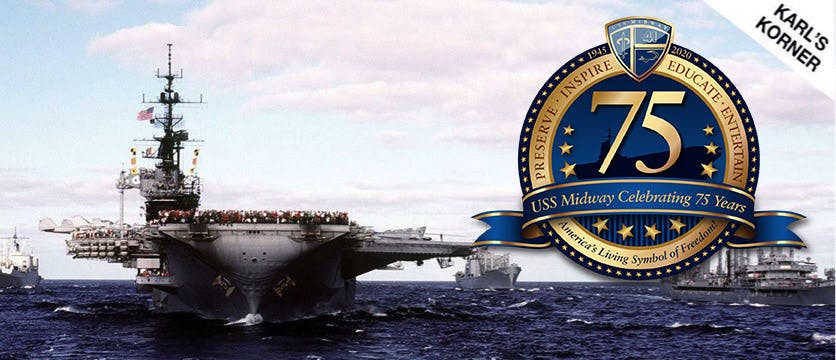 September 28, 2016 | Karl’s Korner
September 28, 2016 | Karl’s KornerBuilding the USS Midway: Part 1
Welcome back to Karl’s Korner, a historical segment written by myself, Karl Zingheim - Ship Historian of the USS Midway Museum. As many of you know the USS Midway celebrated her 71st Birthday this month on September 10th! In honor of celebrating another year preserving the legacy of Midway Magic - I have written a 2 part story of the building of the USS Midway aircraft carrier. Here we go...
Building the USS Midway
The story of the USS Midway actually dates back to the first international attempt at a naval limitation treaty soon after the First World War. Having spent vast sums fighting the war, nations were loathe to engage in a fresh arms race, particularly as the United States was ramping up its naval construction, and Japan was seeking to modernize its navy, now being built exclusively in her own yards. Stealing Britain’s thunder, the new Harding administration called for a naval limitations conference to be held in Washington. In 1922, delegations from every major power from the former wartime allies convened to discuss a variety of issues, particularly regarding rising tensions in Asia and the Pacific region. As far as navies were concerned, the ensuing Washington Treaty not only put the brakes on practically all new construction but defined tonnage ceilings for certain classes of warships, including the newly-devised aircraft carrier. This meant in practice that ships had to be built with compromises in their designs that permitted them to stay within the tonnage restrictions. For aircraft carriers, this typically produced sacrifices like slender armor protection and combining machinery into the same compartments, increasing the likelihood of complete disablement in combat. Another factor that emerged amongst the three carrier navies of the time was the conception of handling aircraft. The American and Japanese navies favored the largest possible air groups on their carriers and designed their ships to maximize their air complements within the size restrictions imposed by treaty. Britain’s Royal Navy, however, was forced to take a different route. As an economy measure right after the First World War, the Royal Air Force (RAF) assumed control of all British military aviation, including the Royal Naval Air Service, later known as the Fleet Air Arm (FAA). Throughout most of the interwar period, while the Royal Navy operated the carriers, it relied upon its sister service for the aircraft and pilots. Moreover, the stringent peacetime budgets meant that even the omnipresent RAF had to prioritize aircraft development for all its needs, which put the FAA at the very bottom in priority. Realizing that the FAA was falling behind technically, Royal Navy ship designers were forced to emphasize passive measures to help protect their future carriers, and so interest was taken in developing carriers with armored flight and hangar decks, even at the expense of how many aircraft could be stored. The result was the Illustrious class, of comparable size to their American and Japanese contemporaries, but carrying no more than half the aircraft. In the meantime, Japan gave notice that it would no longer participate in the treaty system of naval limitations, so after 1938, American designers were finally free to look at producing a new carrier without any arbitrary restrictions. The primary challenge facing the designers was combining maximum protection while preserving the large air groups U. S. carrier doctrine demanded. This required a ship much larger than anything built before, even too large to transit the Panama Canal. By the time design requirements were being tabulated, war had broken out in Europe, and in 1941, the battle-ravaged Illustrious put into Norfolk, Virginia, for repairs. U. S. designers swarmed over the carrier, taking careful note of her armor’s performance. Before long, war had come to the Pacific, and the Navy had the hard examples of how its treaty-era carriers had suffered. These lessons were also factored into the new carrier’s design. By 1943, a new carrier class was ready for construction.
Stay tuned for Part 2...
Karl
Your Adventure Starts Now
Your email is the key to information that will open up all your possibilities for exploring the mighty Midway!

